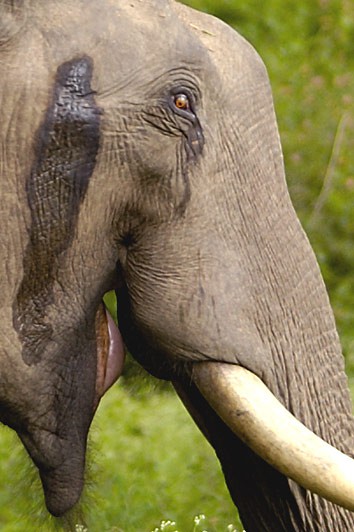One of the important of aspects of this is project is that we're not just saying "hey there is an elephant" but we are detecting which class of elephants are present! Thus, we can infer from our imagery which type of behaviour is likely to be exhibited.
1. Bull Elephants during Musth
These are the most dangerous and aggressive elephants to encounter! Serum testosterone rises from a pre-musth median of 35.16ng/mL to a musth median of 63.88ng/mL in Asian bull elephants experiencing musth. This, and other physiological changes, impact their behaviour "behavior by males
in musth is often abnormal, and can be bizarre and/or extremely
aggressive" (Rasmussen et al, 1999). In addition, during musth, temporal gland secretions were found to contain increased acetone and other ketones. It is speculated that temporal gland swellings during musth may cause the elephants severe pain. Musth lasts for ~16 weeks in Asian elephants (Rajaram, 2006).
These temporal gland secretions result in a thick tar-like deposit on the side of the elephants head which will can attempt to identify from imagery! Thus providing a warning that extremely dangerous elephants are nearby!
 [Image: By Yathin S Krishnappa - Own work, CC BY-SA 3.0, https://commons.wikimedia.org/w/index.php?curid=21406707 ]
[Image: By Yathin S Krishnappa - Own work, CC BY-SA 3.0, https://commons.wikimedia.org/w/index.php?curid=21406707 ]
A bull elephant (African) is thought to come into musth for the first time in his late teens to early twenties. The elephants continue to undergo this period until their early 60s. However, some studies have concluded that older males will to some degree attenuate the aggressive behaviour exhibited by younger males during musth (Slotow et al., 2000).
Additionally, bull elephants will exhibit a distinct vocalisation during their musth period. This is called the musth rumble and sounds like "pulsated "put-put-put" or "glug-glug-glug" quality, like water gurgling through a deep tunnel" (Elephant Voices). You can listen to them here at Elephant Voices.
So we have a visual and auditory method of detecting elephants in the dangerous musth period!
2. Female elephants with calves
3. Tuskers
Since both sexes of African elephant have tusks there doesn't seem much point in looking for these! However, in Asian elephants we can look for tusks as only males have these, with females sometimes having very small tushes. So we can use tusk yes/no to determine sex in Asian elephants.
4. Lone elephants
5. Herds of bulls
6. Herds of females
7. Mixed herds
 Neil K. Sheridan
Neil K. Sheridan
Discussions
Become a Hackaday.io Member
Create an account to leave a comment. Already have an account? Log In.
As we age, the production of hyaluronic acid in the body slows down, leading to a loss of firmness and elasticity in the skin. https://ceporel.com/products/copy-of-gold-hyaluronic-lifting-serum-4
Are you sure? yes | no